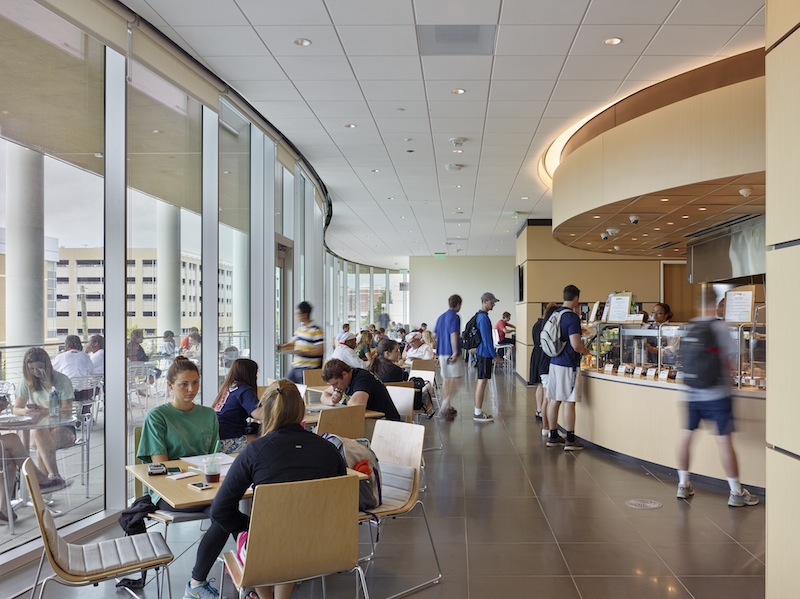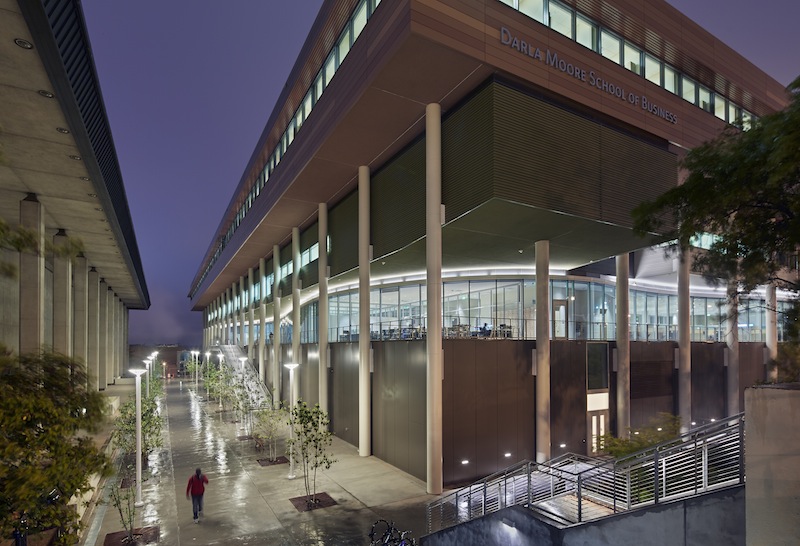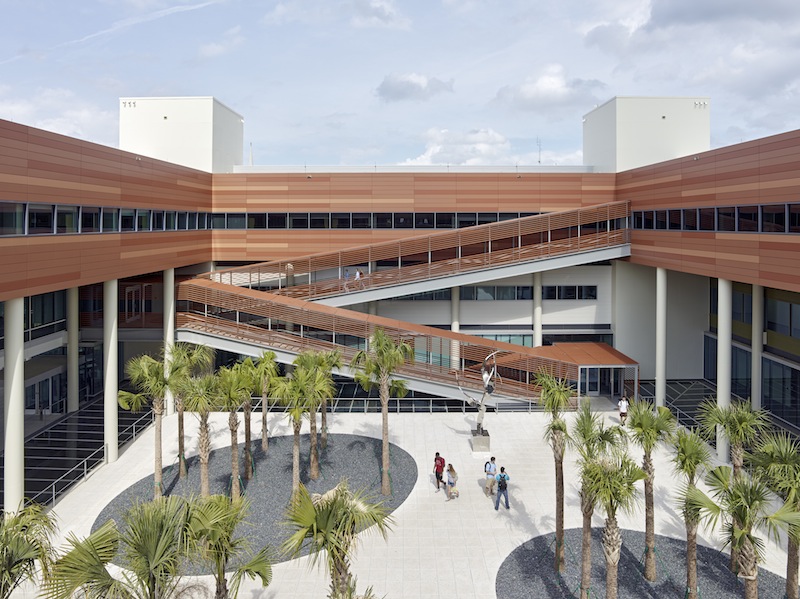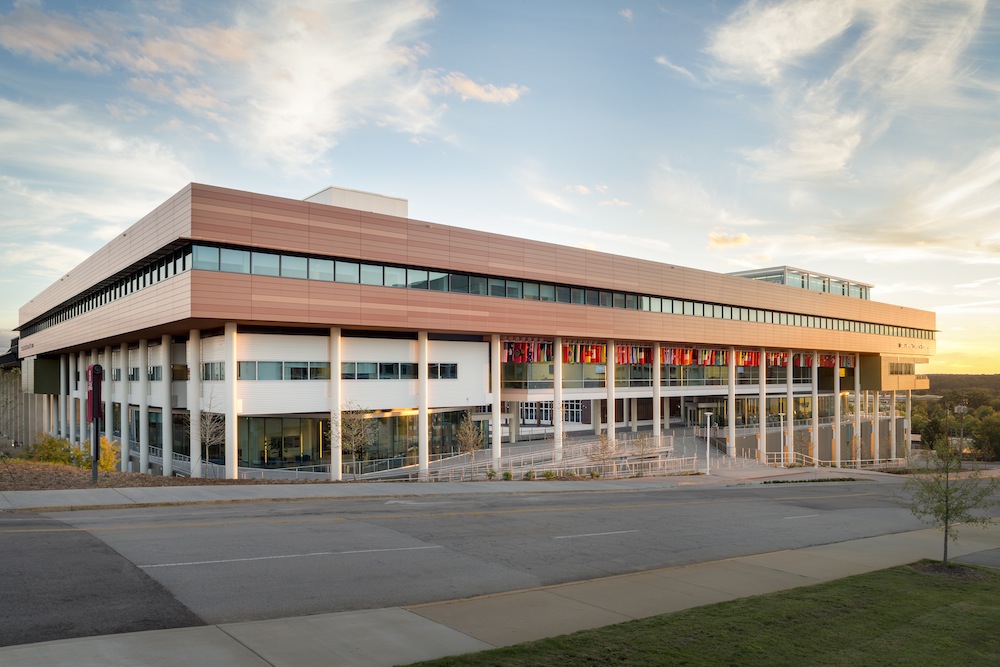Later this year, the newest building at the University of South Carolina’s Darla School of Business expects to achieve LEED Platinum certification from the U.S. Green Building Council.
The 260,000-sf building, which opened in August 2014, is on a path to be recognized as the first net-zero energy higher education facility of its kind in the southeastern U.S.
The university was chosen by the U.S. Department of Energy to partner with Lawrence Berkeley National Laboratory as part of DOE’s Net-Zero Energy Commercial Building Initiative, whose goal is to provide marketable net-zero energy commercial buildings by 2025.
Rafael Viñoly Architects was the architect of record on this $108 million project, and Atlanta-based Stevens & Wilkinson provided the engineering design via its Columbia, S.C., office.
The building’s efficiency features include:
• HVAC systems with under-floor air, active chilled beams, and variable air volumes, all designed to reduce the energy needed to heat and cool the building. A separate HVAC system serves the school’s 500-seat lecture and performance hall. Stevens & Wilkinson also worked with an acoustics consultant, which lead the firm to increase duct sizes for a quieter environment.
• Sustainability is achieved through the use of green turf for heat reduction, reusable waste management systems, and natural daylighting. Rainwater is harvested for irrigation and toilet use, which should the building’s overall water usage by more than 50%.
• Electrical equipment on each of the building’s six levels is charged by two vertical power feeders connected to the building’s main switchgear. An emergency power system services life-safety loads and emergency equipment in the event of power outages.
• An energy monitoring system measures power used by such equipment and components as interior and exterior lighting, heating and cooling, fan motors, elevators, kitchen equipment, and building-plug loads. “Given our region’s hot, and at times, humid climate, our team’s efforts will help curb the amount of energy needed to effectively heat and cool a building of this size and magnitude.” said Keith Branham, PE, LEED AP, Senior Vice President, Director of Engineering for Stevens & Wilkinson.
The net result has produced an optimized energy performance of 43%, which exceeds ASHRAE’s 90.1 standard for these kinds of buildings. The school was made more flexible by incorporating entries on multiple levels. And civil engineering design ensures proper storm water management for flood prevention, site utilities, and government agency approvals.



Related Stories
| Oct 12, 2010
University of Toledo, Memorial Field House
27th Annual Reconstruction Awards—Silver Award. Memorial Field House, once the lovely Collegiate Gothic (ca. 1933) centerpiece (along with neighboring University Hall) of the University of Toledo campus, took its share of abuse after a new athletic arena made it redundant, in 1976. The ultimate insult occurred when the ROTC used it as a paintball venue.
| Oct 12, 2010
Owen Hall, Michigan State University, East Lansing, Mich.
27th Annual Reconstruction Awards—Silver Award. Officials at Michigan State University’s East Lansing Campus were concerned that Owen Hall, a mid-20th-century residence facility, was no longer attracting much interest from its target audience, graduate and international students.
| Oct 12, 2010
Cell and Genome Sciences Building, Farmington, Conn.
27th Annual Reconstruction Awards—Silver Award. Administrators at the University of Connecticut Health Center in Farmington didn’t think much of the 1970s building they planned to turn into the school’s Cell and Genome Sciences Building. It’s not that the former toxicology research facility was in such terrible shape, but the 117,800-sf structure had almost no windows and its interior was dark and chopped up.
| Oct 12, 2010
The Watch Factory, Waltham, Mass.
27th Annual Reconstruction Awards — Gold Award. When the Boston Watch Company opened its factory in 1854 on the banks of the Charles River in Waltham, Mass., the area was far enough away from the dust, dirt, and grime of Boston to safely assemble delicate watch parts.
| Oct 12, 2010
Building 13 Naval Station, Great Lakes, Ill.
27th Annual Reconstruction Awards—Gold Award. Designed by Chicago architect Jarvis Hunt and constructed in 1903, Building 13 is one of 39 structures within the Great Lakes Historic District at Naval Station Great Lakes, Ill.
| Oct 12, 2010
Full Steam Ahead for Sustainable Power Plant
An innovative restoration turns a historic but inoperable coal-burning steam plant into a modern, energy-efficient marvel at Duke University.
| Oct 12, 2010
From ‘Plain Box’ to Community Asset
The Mid-Ohio Foodbank helps provide 55,000 meals a day to the hungry. Who would guess that it was once a nondescript mattress factory?
| Oct 11, 2010
HGA wins 25-Year Award from AIA Minnesota
HGA Architects and Engineers won a 25-Year Award from AIA Minnesota for the Willow Lake Laboratory.
| Oct 11, 2010
Rhode Island is the first state to adopt IGCC
Rhode Island is the first state to adopt the International Green Construction Code (IGCC). The Rhode Island Green Buildings Act identifies the IGCC as an equivalent standard in compliance with requirements that all public agency major facility projects be designed and constructed as green buildings. The Rules and Regulations to implement the Act take effect in October 2010.
| Oct 8, 2010
Union Bank’S San Diego HQ awarded LEED Gold
Union Bank’s San Diego headquarters building located at 530 B Street has been awarded LEED Gold certification from the Green Building Certification Institute under the standards established by the U.S. Green Building Council. Gold status was awarded to six buildings across the United States in the most recent certification and Union Bank’s San Diego headquarters building is one of only two in California.
















